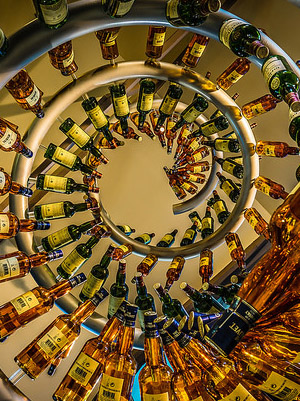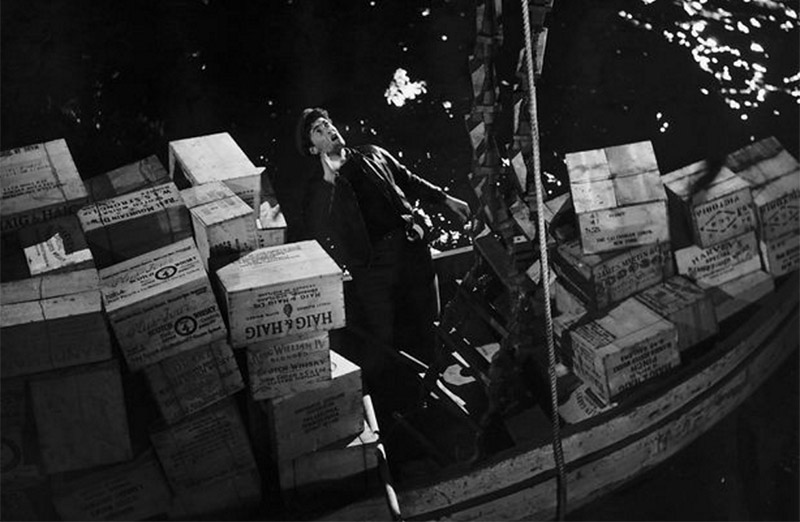If you delight in partaking of a dram of whisky, you likely delight in what I think of as whisky extracurriculars. There are some foods and drinks for which savoring them directly is the height of our experience with them, but any whisky buff will tell you that there’s a bit extra with the water of life.
I’ve been a devotee of Islay whisky for a decent chunk of my life, loving how the essence of sea and coast can be distilled into a glass, with aspects of brine, seaweed, the iron of terra firma, peat, and the smoky fingers of the kiln playing around one’s nose and tickling the back of one’s throat. The island of Islay produces the most intense whisky in Scotland. Many drinkers prefer the more honeyed malts of the Highlands, though if you drink one you tend to drink the other. What’s ironic in my case is that I’ve given up drinking entirely, for a host of reasons — isn’t that always the way in these matters? — and yet my relationship with whisky, post-drink, continues on.
That’s one of the reasons I’m so fascinated by the 1949 film, Whisky Galore!, which is based on the novel of the same name by Compton Mackenzie, an author few people remember today.
If you’ve come across his name, you’re probably an F. Scott Fitzgerald fan, as he was a big admirer of Mackenzie’s Sinister Street. Whisky Galore! was one of his biggest hits, with its basis in a true story. In 1941, the S.S. Politician ran aground off of the Hebridean island of Eriskay. She was carrying a lot of cash — quite a bit of which was never recovered — and a lot of whisky, which, wouldn’t you know, disappeared faster than the cash on account of the local islanders. When you gotta have the brown, you gotta have the brown.
It’s an amusing anecdote, and one that grew in lore over the years, but while it had a handsome payoff in the Mackenzie novel, the film that followed was the real blessing. It was made by Ealing Studios, a London-based company that turned out some of the most winsome, rascally, and charming comedies of all-time in the 1940s and ’50s.
Alec Guinness made two of his finest pictures here in The Lavender Hill Mob (1951) and The Ladykillers (1955), but it’s Whisky Galore! that synthesizes the most ideas in a single, guffaw-generating film. And, like the best films of that sort, it recalibrates your thoughts and your previous expectations and makes for an epiphany or two.
Whisky is a spirit that plays well in literature, just as boxing, say, is a sport that also does. Beer does less well, wine has literary merit in Balzac and Hemingway novels, there is the highball in the work of Fitzgerald, but whisky has wonder and romance built into in a manner that transposes readily to the page, and, with a literate film director — which we have in Alexander Mackendrick — to the screen as well.
There are evenings where I enjoy relaxing not with a dram, but by taking down one of my guides to whisky and reading the tasting notes, or doing so online. Keats would have brought out a notebook to jot down some of the phrases one encounters — “medicinal, phenolic, seaweedy, with a hint of estery (gooseberry?) sweetness,” to borrow one from Michael Jackson’s Complete Guide to Single Malt Scotch — as they play so readily both on the imagination and on the palate, before the whisky has even cleared the lips. There aren’t many spirits that occupy a place in the mind so resolutely as a place in the mouth. Absinthe might be another, but that’s probably about it.
Whisky Galore!, understanding this, begins with a number of establishing shots featuring the wind-lashed sea, scenes from around a crofter’s home, a pan of a peat-laden stretch of bog, for this is the stuff of whisky, and there’s a reason why whisky drinkers are always describing the color of their dram, and the nose of it — which is to say, how it smells.
There’s romance afoot, but it’s rugged romance sourced from earth and sea, which Whisky Galore! establishes immediately, thus imbuing whisky, or our notions of it, with a cinematic quality. The allure has been made visual, so that when a tavern keeper announces that he’s down to his last few bottles, calamity kicks in.
An Ealing comedy has a lot of what we might think of as quiet laughs. Laughter that will rise up slowly in you, emit from your mouth in a few extra-breathy exhalations, then rise up in you later when you think about what you’ve seen. It’s a subtle form of comedy, but one that lasts longer than any pratfall.
We don’t often think of war rationing as impacting the spirit industry, for surely spirits are not that important, and a man with an overturned glass and a scolding look on his face wouldn’t make for a series of WWII posters at the level of Rosie the Riveter. You can drink later, after the war. But maybe it’s not that simple if you’re someone for whom whisky is an integral part of your culture, and what I think of as one’s personal culture: that which they’ve absorbed from their surroundings, their people, their life, and internalized and transformed to make them, in part, into the person they are. And that’s what whisky is in this charmer of a film.
When the news reaches the publican and his mates that a ship has gone aground carrying 50,000 cases of whisky, a plan is launched. The islanders will row themselves out to the wreck, gather up their treasure, and stash it in a cave by the beach.
They set out at midnight under cover of darkness, and watching the figures mass on a cliff is like something out of an Orson Welles Shakespeare production — stately, foreboding, urgent but quiet, with the feeling that silence is about to be pierced by a demon cry. Then one of the would-be raiders realizes that it is a minute after midnight on the Sabbath, and while it’s cool to burgle, it’s not cool to burgle on the Lord’s day. Downtrodden, they retreat to their homes and then to Sunday service.
This is the kind of comedy that Ealing excelled at, and in Whisky Galore! it’s crossed with a longing that becomes poetic, the notion that if this particular desire is not satiated, it will cost each individual a portion of their very individuality, even within the ranks of a group. For such is the power of whisky when whisky is more than mere drink, more spirit.
Some people, like myself, might turn to literature or art like this film, but the islanders turn to the task itself, which comes to count for more, in a way, than their beloved liquid. The journey, if you will.
There is a highly officious Home Guard Captain who attempts to thwart them, which makes for some tension in the plot, but he’s never treated as a draconian figure or a stooge, rather someone who hasn’t quite come to understand — yet — what the islanders do. When your meaning has been taken from you, you have to find a way to grab it back, or cast some anew. Whisky is just the common denominator of those processes for these people.
They are on their honor, once they have their treasure in the cave, with a leader saying that each man should take what he needs, for our needs vary from person to person. It’s a richly resonate line, and some walk out with two bottles, others four, what have you, with the pacing of the scene being such that you can feel the introspection in the air, that notion of taking what one needs doubling as something beyond dram matters.
Of course, much the same effect is produced when one sits over a glass of a favorite whisky, or in the warming glow after, with other concerns being pondered over with a little more oomph, and a little more faith that a case-sized problem can be broken down to the size of a few mouthfuls. The whisky that is whisky and beyond whisky, the water of life served neat. •
Feature image courtesy of ScottSimPhotography via Flickr (Creative Commons). Screen captures taken from film.





